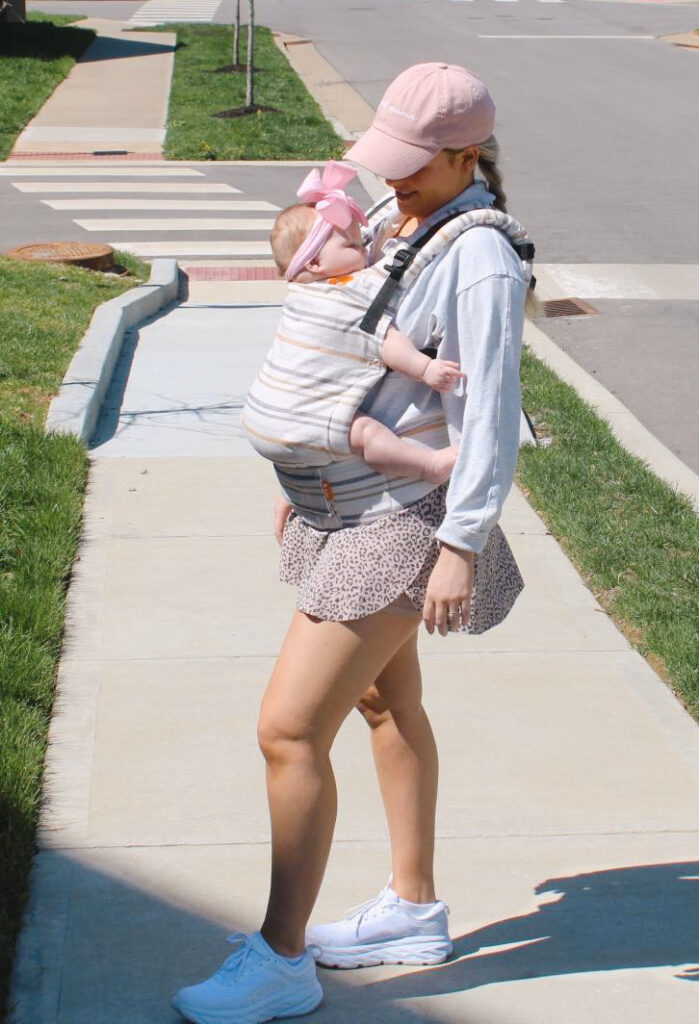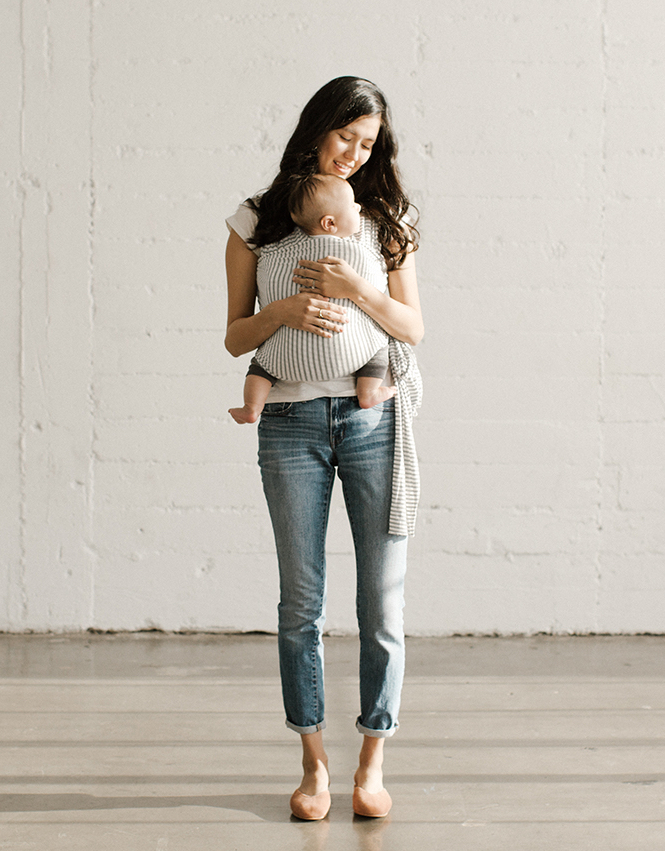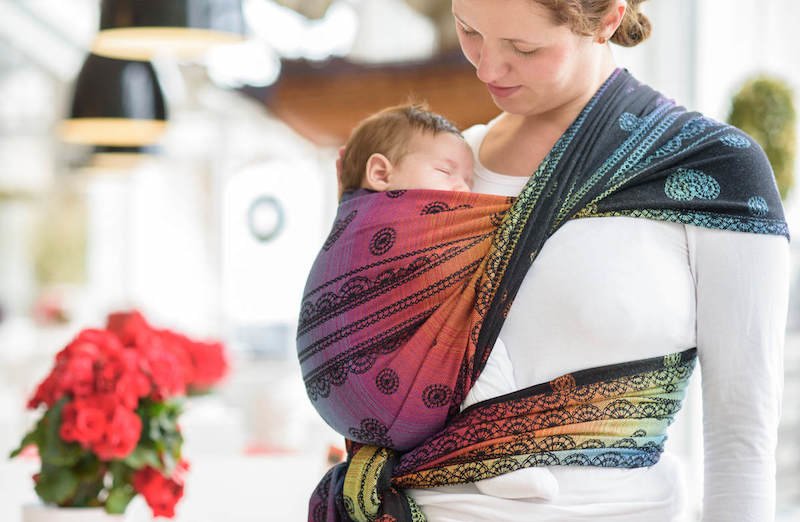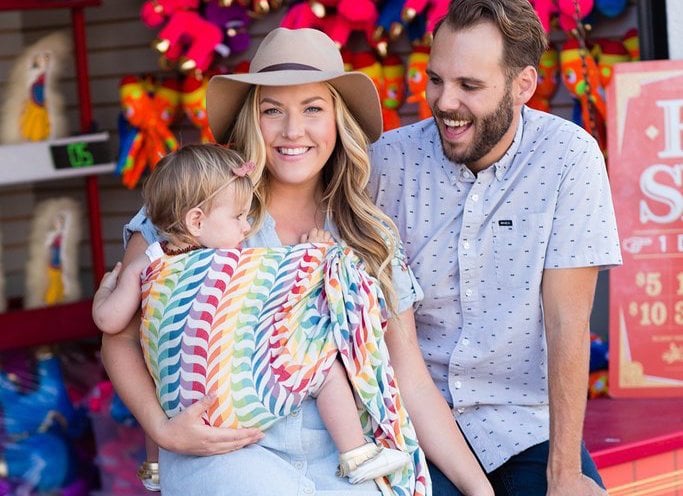Babywearing Basics: Complete Guide to Baby Carriers, Wraps, and Slings
“Babywearing” is a modern word for an ancient practice, a practice that goes back to the dawn of time. And it’s an attachment parenting method that is still widely used today… for good reason. Babywearing is seamlessly compatible with this thing we call life.

That being said, it doesn’t mean that wearing your baby will be instinctual and easy from the beginning.
It takes time, practice, and troubleshooting to get your baby into a baby carrier. Though, once the connection is made, and with continued practice, babywearing can become second nature.
Wearing your baby can…
- offer newborns the constant warmth and security they need
- enable simple on-demand breastfeeding
- give parents of babies of any age back their hands so they can attend to other needs
Imagine navigating a hiking trail, exploring a decommissioned Soviet nuclear submarine, or just grocery shopping in the middle of naptime, with a stroller! It can be done. But babywearing makes so many moments easier for parents and caregivers.
Basically, babywearing can make you feel like you have superpowers. And that can mean everything during those sleep-deprived, what-am-I-doing, nonstop-screaming early stages of parenthood.
Table of contents
- Babywearing Wraps and Carrier Styles
- Soft Structured Carriers (SSCs)
- What to Know About Soft Structured Carriers (SSCs)
- Stretchy Baby Carrier Wraps
- What to Know About Stretchy Baby Wraps
- Woven Babywearing Wraps
- What to Know About Woven Babywearing Wraps
- Ring Slings
- What To Know About Ring Slings
- Other Babywearing Carrier Styles
- Babywearing and Cultural Appopriation
- Babywearing Safety 101
- TICKS RULE
- Babywearing Troubleshooting
- How to Become a Babywearing Educator
Babywearing Wraps and Carrier Styles
There are many different types of babywearing wraps and carriers available, and each can shine in varying situations and developmental stages.
- Soft structured carrier
- Babywearing wrap – both stretchy and woven
- Bei Dai/Meh Dai
- Ring sling
Finding the sweet spot, and the right carrier for you may take some trial and error, but the pay-off is worth it!
Soft Structured Carriers (SSCs)
You may see soft structured carriers called Ergonomic Canvas Carriers or Buckle Carriers. Ergo was one of the first brands to make SSCs popular. And now brands like Tula and Lillebaby have added more options to the mix. The ease of use and comfort they provide make them a fan favorite among parents.
People love soft structured carriers because they’re easy to use, easy to adjust, and breastfeeding-friendly. But without a doubt, their biggest selling point is their comfort.
These kinds of babywearing designs are so body-friendly, you can wear them for hours on end. Hours that can be comfortably spent walking, hiking, working at a desk, washing dishes, or picking up LEGO bricks so that no one has to suffer the consequences.
Most SSC’s can be worn front, back, and even to the side as a hip carry. There are also carriers like Lillebaby’s COMPLETE or Ergobaby’s 360 that can pull off an ergonomic forward-facing front carry (though it is important to note that forward facing carries can be less comfortable for the wearer when worn for extended periods of time).
What to Know About Soft Structured Carriers (SSCs)
Of course, SSCs have some limitations. Some carriers just can’t accommodate newborns. You can buy an extra attachment for newborns. Once they hit around 3 months they’ll be too big for it, yet their hips will be too small to sit in the carrier alone (with exception to the carriers that offer a snap adjustment).
If you would prefer an SSC that will work from newborn up, you’ll want to buy one that’s specially designed with mods for newborns (ie. Beco Gemini, Ergo Adapt, and Catbird Pikkolo). Extra-large toddlers may also require special accommodations, like with a special toddler-sized carrier.
Once you get past the newborn stage, or you buy one meant for a newborn as well, these carriers are absolutely worth the money. Parents are even using the same carrier for all of their children, and some are even toting kids up to age five. Costs vary from around $85 to $150, and it’s money well spent.
Stretchy Baby Carrier Wraps
This style of wrap is popular, especially for younger babies. They also tend to be rather stylish, affordable, and comfortable. The wide fabric allows for even distribution of baby’s weight for mom or dad. Plus, the stretchy and cozy design is heaven for sleepy newborns and makes them ideal for Kangaroo Care.
This style of babywearing wrap can be the perfect gift for new parents, because it allows for 24/7 contact. New parents can bond with their baby while still maintaining the use of their hands.
Stretchy baby wraps are typically composed of natural fabrics, like cotton, bamboo, or blends with a small percentage of spandex or polyester. This kind of fabric can also be found at your local fabric shop, so if you have skills in the sewing department, you can make your own baby wrap.
What to Know About Stretchy Baby Wraps
One potential drawback to the stretchy wrap style is that they can get hot. And depending on the fabric weight, they’re not always interchangeable between babies and toddlers. Typically, bigger tots are more comfortable to carry in a supportive fabric like 100% cotton. Tiny newborns, on the other hand, are better off in a softer wrap fabric like a cotton/spandex blend.
Another con to stretchy wraps is that they’re mostly limited to front and side carries. And they can be of the more difficult kind of babywearing style to master. But at about $40 and with a few YouTube tutorials they can be an inexpensive way to your dip toe in the waters of wearing your baby.
Woven Babywearing Wraps
Visit a natural parenting group or cloth diaper club and you’ll find an endless array of beautifully woven wraps enveloping sweet, chubby-cheeked babies. This style of baby wrap is very popular thanks to their beautiful designs, lovely colors and breathable break-in-able natural threads.
They’re most often made of natural fibers like bamboo, hemp, cotton, and linen. Longer woven wraps open up a magical new world of eye-catching ties and carries.
Lenny Lamb ‘Rainbow Lace Dark’ Woven
Some of the most notable woven producers include Didymos, Lenny Lamb, Tula, and USA-manufactured Butterfly Baby. A good woven wrap will be an investment of around $75-200 and will securely and comfortable hold your baby from birth to toddlerhood.
There are parents that just can’t get enough of woven wraps (literally, their wrap cache is taking over their homes and their partners are concerned they may need to stage an intervention). Then there are those that find woven wraps with five meters of fabric a little overwhelming.
Related: Navigating the Learning Curve of Wraps
What to Know About Woven Babywearing Wraps
If you find this kind of babywearing wrap intimidating, you might feel more comfortable with a wrap/carrier cross like the Bei Dai/Meh Dai.
Meh dai (in Cantonese pronunciation) or bei dai (in Mandarin pronunciation) are rectangles of fabric with straps coming out from each corner of the panel. Meh dai means “back-carrying strap,” where “meh” or “bei” means “carry on your back,” and “dai” means “strap.” (source)
This kind of baby wrap has a square or rectangular body panel with four straps attached. The baby can be worn either in the front or back. Simply seat baby in the panel section and adhere the straps around your body. This option also grows with your baby.
Still feeling more tangled than tempted?
Before you give up on wovens, you should know their intimidation has the perfect remedy; ring slings. Loop that woven through a pair of rings and you have a super simple sling to use while you master the art of tying.
Ring Slings
Ring slings are wonderful babywearing options because they’re so simple to put on. And the ease of ring slings is truly nothing short of magic when you have a breast-loving newborn or a store-wandering toddler. With rings slings, you can have your tot on your hip quicker than you can say, “Don’t touch that!” Plus, you can actually shop with two hands!
Tula Migaloo Happy
One plus to the ring sling babywearing style is that they aren’t as long as a woven wrap. And that can be a bonus when it comes to, say, toilets, or rain puddles. And ring slings can be adjusted to fit the baby or the wearer. And the style offers a stream of fabric that can double as a nursing cover.
Since they’re a smaller length of fabric compared to woven and stretchy wraps, they’re also super easy to toss in a bag or stash in a car. Even better, they’re available in a range of prices and quality thanks to brands like Soul Slings, Maya Wrap, Oscha Slings and Beco.
What To Know About Ring Slings
While the benefits of a ring sling make it nearly impossible for them to disappoint, there are a few things to keep in mind. Ring slings are great for newborns but carrying bigger babies for an extended period of time can quite literally become a pain in the neck.
This is common for carries to one side, since all of the weight is often distributed to one shoulder. And special care needs to be taken with positioning newborns so that their airways are open and their necks aren’t overextended.
Any possible cons aside, it’s hard to go wrong with a ring sling. They’re simple to use, easy to pack up, great for nursing, can be used between babies and toddlers, and they take just seconds to put on.
Other Babywearing Carrier Styles
There are a variety of specialty carriers like the Baby Bjorn, Peanut Shell, Hotsling and K’Tan. These types of baby carriers are great for parents who may be intimidated by a higher price tag. These babywearing styles tend to be less expensive.
And they also address the intimidation parents feel with wraps because they’re pre-sewn with little to no tying required. This kind of simplicity and affordability can be a big selling point for parents.
While specialty carriers do have many positive qualities, there are some areas where they can fall short. Specialty carriers may have more limitations on the age ranges that they can accommodate. They may also require more specific sizing for the wearer (making it less seamless, or impossible, for all caregivers in a family to utilize the carrier).
Babywearing and Cultural Appopriation
Early humans likely made carriers from animal skins, plants and other natural materials about half a million years ago to keep their babies safe while attending to daily life. University of Notre Dame anthropology professor, James McKenna, says these carrying devices were some of the first tools ever created. (source)
There’s been some controversy in recent years over babywearing brands appropriating some of the styles and patterns of carriers that have been around for centuries and claiming them as their own creations.
While most of the brands in question have corrected their mistakes and pledged to do better, it leaves the question: If I wear my baby, am I participating in cultural appropriation?
This article by Jennifer Lee takes a deep dive so you can understand why it has been problematic. To us, the takeaways are
- Babywearing brands should be held responsible for researching and giving credit for the products they bring to market (this also helps involve and employ women from other backgrounds)
- Parents should educate themselves and give credit and appreciation for the tools we’ve gleaned from other cultures
Babywearing Safety 101
When it comes to babywearing safety, there are several factors to consider. If you’re interested in a soft-structured carrier, you’ll want to choose an established brand with years of experience in creating safe, ergonomically correct carriers to protect baby’s spine and hips. It’s also important to keep baby facing inward (toward you) for at least the first 6 months.
You’ll want to make sure you’re always following these guidelines for safe babywearing. The TICKS rule is a helpful guideline to keep in mind.
TICKS RULE
T = Tight – Slings and carriers should be tight enough to hug your baby close to you. Any slack/loose fabric will allow your baby to slump down in the carrier which can hinder their breathing and pull on your back.
I = In view at all times – You should always be able to see your baby’s face when you glance down. The fabric of a ring sling or carrier should not cover them from your sight. In a cradle position your baby should face upwards and not be turned in towards your body.
C = Close enough to kiss – Your baby’s head should be as close to your chin as is comfortable. By tipping your head forward you should be able to kiss your baby on the head or forehead.
K = Keep chin off chest – Your baby should never be curled so that their chin is forced onto their chest. That position can restrict their breathing. Ensure there is always a space of at least a finger width under your baby’s chin.
S = Supported back – In an upright carry a baby should be held comfortably close to the wearer so their back is supported in its natural position. And their tummy and chest are against you. If a sling is too loose they can slump. This can partially close their airway. (You can test this by placing a hand on your baby’s back and pressing gently – they should not uncurl or move closer to you.) A baby in a cradle carry in a pouch or ring sling should be positioned carefully with their bottom in the deepest part. This is so that the sling does not fold them in half pressing their chin to their chest.
Babywearing Troubleshooting
When troubleshooting a carrier or trying a new position, a few tips and some preparation can help to make the experience enjoyable for both caregiver and baby.
First, check out the manufacturer’s instructions and any videos they may have available. Study, and practice in front of a mirror with a doll or stuffed animal. Once you are ready to try with baby, wait until they are content.
Not too hungry, not too sleepy, clean diaper on… basically “just right,” as Goldilocks would say!
When getting started wearing a newborn, ask a partner or friend to spot you. And if that isn’t possible try kneeling or leaning over a bed or other soft surface. Your baby will take her cues from you, so try to stay calm and focus on getting her in safely and comfortably.
Your baby may need some motion or white noise to help her settle into her new ride. Practice wearing your baby while vacuuming, washing dishes or simply walking around the house.
If you need a little more help, or don’t feel like you have the right carrier look for local babywearing educators or a babywearing group. And, most importantly, keep trying.
How to Become a Babywearing Educator
One day, you might even want to consider becoming a babywearing educator yourself. Anyone can become a babywearing educator. All it takes is knowledge and keeping up on the best-practices.
There are certification programs offered by places like the Center for Babywearing Studies. This particular program offers an intense four day training program.
Educators are important because babywearing is a learning process. Babywearing used to be passed down from generation to generation within families. But today, we go to a store and buy a carrier without much guidance. Educators are there to assist new parents in their homes, demonstrate safe-practice, and advise on the best carriers for individual needs.



